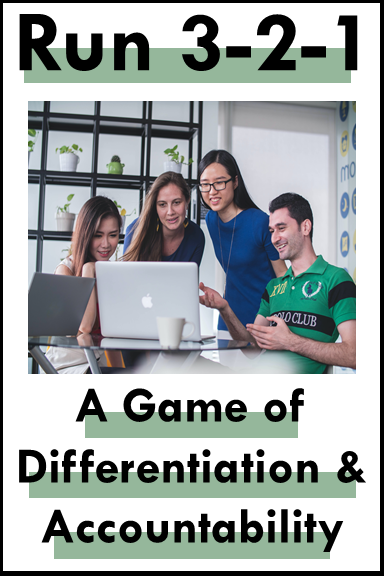This is a fun classroom game to get your students moving, problem-solving, and collaborating with one another. Its fast-paced nature encourages students to be competitive and strongly incentivizes them to get some math practice in for the sake of sweet victory against their classmates.

Object of the Game
The object of the game is to get the most points before the time ends OR to get to a “target” point score within a certain time.
Materials
- Task Cards with Questions
- A Run 3-2-1 Student Score Sheet for students to fill in
- Optional: Hint Cards
How to Play
First, arrange students into teams- they can work in groups or pairs, but the game will still run smoothly if they wish to work individually.
Place the task card questions on a table near you. Students will come up and choose the problems they want to work on. There should only be one task card per group at a time, otherwise the students may ‘divide and conquer’ multiple problems and not collaborate with teammates.
When the students answer a question, they will come up to you to get it checked. If they get it correct on the first try they earn three points. If not, they can try again for two points, and then one point.

Only have one student at a time come up to you to get their answer checked per group or you might incur a tsunami of kids crowding around your desk. Students should rotate who comes up to you so you can hold each member of the group accountable with understanding the material. If a student gets the correct answer to the problem but cannot answer a “checking for understanding” question, they will have to go back and discuss the problem with their team.
Scoring/Differentiation
- Give each team a “target” point goal based on their grade or skill level. The lower level students will feel a sense of accomplishment when they get to their “target” score. Be careful that the students don’t feel “incompetent” though if you give them a lower target score than another team.
- Another way to score in this game is to tell them that a certain “target” score will give you a specific grade for the assignment. For example, if a student gets 30 points (that’s the equivalent to getting 10 questions correct on the first try) then they would earn an A. Twenty points would earn a B, etc…
- You can also put point values on the different difficulty levels of the task cards. Students can choose the easiest cards, but they will have to answer more of them to get the highest score. You can challenge certain teams to try more difficult problems if you feel they are ready.
Help Cards
Offer the students 3 “help” cards. If a group needs a hint, they can come up to you and ask about a certain problem.

Student Rules
- Students must work together and make sure everyone on the team understands the problem before coming up to the teacher.
- Be patient with your partner(s). Do not try to rush them to come up to the teacher until they understand the material.
- Only one student at a time comes up to the teacher to check answers.
- In order to check answers, you need your card and scoring sheet.
- When you are finished, leave the task card on the table for another group and choose a new one to bring to your group to work on.
- A different student must come up to see the teacher after you’ve solved each problem.
- If you get a problem incorrect, go back to your group and try again. In this case, the same student must come up to get the answer checked by the teacher since it is the same problem.
Score Card Explanation
Each time a student comes up to answer a question, write their name, problem number, and points if they get it on the first try. Ask them a question to make sure they understand how to do the problem before you give them points. If the student does not get the correct answer OR gets the answer correct but not the explanation, send them back to their group to try again.
The reason to put each student’s name on the score card is to make sure the same person comes up to you if they are sent back to the group. It is also to make sure that students are rotating on who comes up to you and are all held accountable for the concepts, and that it is not always the same person.
CLICK HERE TO RECEIVE AN EDITABLE COPY OF THE SCORE CARD, RULES, AND HELP CARDS!
Here are some Algebra resources to use for “Run 3-2-1″.
Mini Task Cards about Quadratics
Mini Task Cards about Linear Functions
Here are some middle school resources to use:
Converting Fractions to Decimals to Percents
Multiplying and Dividing Fraction Word Problems
or Check out my store for all the resources!
Click here to learn about another fun review called “The Grid Game”.
What kinds of review games do you play with your students? Let me know in the comments below.




